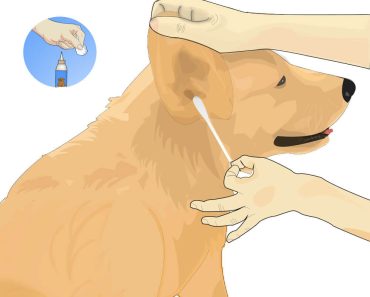
Ticks are a major concern for pet owners, especially those who own Golden Retrievers. These friendly, furry companions are known to spend a lot of time outdoors, making them susceptible to ticks. Ticks can transmit various diseases to dogs, such as Lyme disease, Babesiosis, and Rocky Mountain spotted fever. In this article, we will explore the causes, prevention, and treatment of ticks on Golden Retrievers.
Table of Contents
What are the different types of ticks that can be found on Golden Retrievers?
American Dog Tick –
These ticks are commonly found in the Pacific Northwest, Midwest, and Eastern United States. They are most often found in recreational areas and hiding amongst plant growth close to paths, roads, and trails. Dogs and humans are the prime target hosts for these ticks. Although they do not transmit Lyme disease, they can carry infections and diseases that can be harmful to both dogs and humans. American dog ticks can also release a toxin that can lead to tick paralysis on the host.
Lone Star Tick
Lonestar ticks are found in heavily wooded areas and near rivers and creeks in the East, Midwest, and Southeast regions of the United States. They can even be found near more urban areas in Pennsylvania. These ticks can transmit serious diseases such as Tularemia and Ehrlichiosis to dogs and humans.
Blacklegged Tick
Blacklegged ticks can transmit Lyme disease and other potentially dangerous diseases such as Anaplasma and Ehrilia to both dogs and humans. Initially present only in the Northeast regions of the US, they have been reported as far south as parts of Virginia and Pennsylvania in recent years. They are commonly found in wooded or suburban areas.
Brown Dog Tick
These ticks are common across the United States, Canada, and Australia. They can cause significant trouble for dogs, the least of which is skin irritation. When they assemble in large numbers to feed on a dog’s blood, anemia becomes inevitable due to massive blood loss. Unlike the other tick species mentioned here, these ticks rarely bite people.
Other Types of Ticks
The Center for Disease Control and Prevention (CDC) reports other tick species found in the United States, including Groundhog ticks, Gulf Coast ticks, Rocky Mountain ticks, Soft ticks, and Western black-legged ticks.
What is the tick life cycle and behavior
Ticks are parasitic arachnids that go through a complex life cycle consisting of four different stages. The first stage is the egg stage, which is followed by the six-legged larva stage. After hatching from the eggs, the larvae are very small and must find a host to feed on. Once they have fed, they molt into the next stage, the eight-legged nymph. The nymph stage also requires a blood meal, and after feeding, the tick will molt again into the adult stage.
Ticks need to feed on blood at each stage of their life cycle to progress to the next stage. It is important to note that ticks can carry diseases, and as they feed on blood, they can transmit these diseases to their hosts. It can take up to three years for a tick to complete its entire life cycle, and most ticks will die because they are unable to find a host for their next feeding.
Where are ticks most commonly found on dogs?
Check your dog regularly, especially if they wander through tall grass or brush, to prevent tick infestations. Tick bites can be difficult to detect and don’t usually cause itching, so checking your dog once or multiple times daily in high-risk areas can help find ticks before they detach from your dog.
Here are seven areas on golden retrievers where ticks commonly hide:
Head and Ears:
Golden retrievers love exploring, so it’s not uncommon for ticks to attach to their head and ears. Be sure to check the outside and inside of your dog’s ears for any signs of ticks, especially if your dog is shaking their head or scratching at their ears.
Toes:
Ticks can hide between your golden retriever’s toes or on the bottom of its feet near the pads. Watch for any signs of licking or chewing on their feet, as this could be a sign of a tick infestation.
Tail:
Ticks prefer dark and moist areas, making the underside of the tail a common hiding spot. Make sure to comb through your dog’s fur and check the base of its tail for any signs of ticks.
Groin:
Although it may be uncomfortable for some owners, it’s important to check your golden retriever’s genital region for ticks. Ticks can attach and stay hidden in this area for a long time.
Eyelids:
Ticks can often go unnoticed near the eyelids, which can lead to transmission of diseases if not detected early. Check your golden retriever’s eyelids regularly and seek veterinary attention if you notice any ticks.
Under the Collar: Ticks can attach underneath your dog’s collar without being noticed, so it’s important to remove the collar and check thoroughly for any signs of ticks.
Armpits:
The armpit region, where your dog’s front legs meet its body, is another common area for ticks to attach. This area is difficult to reach and can be easily overlooked, so make sure to check thoroughly during tick checks.
Which diseases are spread by ticks?
Although there are many of them, the four most prevalent diseases transmitted by ticks are:
Lyme Disease
Lyme disease is the most common tick-borne illness in the United States, particularly in the Southeastern and Northeastern regions. It causes several severe symptoms such as loss of appetite, depression, renal failure, swollen lymph nodes, and fever. Both humans and dogs can contract this disease. If you suspect your pet has been bitten by a tick and is showing signs of Lyme disease, it is crucial to seek immediate veterinary attention to prevent further complications. Prompt diagnosis and treatment can help your pet recover quickly and avoid long-term health consequences.
Ehrlichiosis
Ehrlichiosis is a severe tick-borne illness that is primarily carried by brown dog ticks. The disease causes various symptoms, including fever, loss of appetite, abnormal bruising, lethargy, and lymph node enlargement.
If your dog displays any of these symptoms, it is important to take them to the vet immediately for diagnosis and treatment. Early intervention can increase the chances of a successful recovery and prevent the disease from becoming more severe.
Neglecting to seek prompt medical attention can lead to further complications that can be more difficult to treat, so it is vital to act quickly.
Anaplasma
Anaplasma is a disease caused by a bacterium carried by the Black-Legged Tick (Ixodes). While it can be found worldwide, there are two Anaplasma species known to cause disease in dogs in North America:
Phagocytophilum, which is prevalent in the Northeast and upper Midwestern United States, and Platys, which is common in California and coastal states.
Dogs with Anaplasma may display similar symptoms to those of Lyme disease, such as lethargy, fever, and loss of appetite.
However, dogs with Anaplasma often experience low blood platelets, which can lead to bleeding disorders. If you suspect that your dog has been exposed to ticks and is showing symptoms of Anaplasma, it is crucial to seek veterinary care promptly.
Rocky Mountain Spotted
Rocky Mountain Spotted Fever is a tick-borne illness that is transmitted by American, brown, and Rocky Mountain dog ticks. It is widespread throughout the United States and can cause a range of symptoms, including vomiting, lethargy, and stomach pain.
It is essential to seek veterinary care if your pet is exhibiting any of these signs after being bitten by a tick. Early treatment can double the chances of a successful recovery and help prevent further complications. If left untreated, the disease can become more severe and result in long-term health issues.
Don’t hesitate to contact your veterinarian if you suspect your pet has contracted Rocky Mountain Spotted Fever or any other tick-borne disease.
How to Remove a Tick from Your golden retriever
Using Fine-Point Tweezers to Remove a Tick from Your Golden Retriever
To remove a tick from your golden retriever, use fine-point tweezers instead of household tweezers with large, blunt tips. Spread your dog’s fur and grasp the tick as close to the skin as possible. Gently pull the tick straight upward with a slow, steady motion to prevent the tick’s mouth parts from breaking off and remaining embedded in the skin.
Remember that ticks don’t have heads, so what gets inserted into your dog is known as “mouthparts.” After removing the tick, wash your hands thoroughly, clean the bite site with rubbing alcohol, and disinfect the tweezers.
Using a Tick Removal Hook to Remove a Tick from Your Golden Retriever
Another option for removing ticks from your golden retriever is to use a tick removal hook. This method is especially useful if you live in an area with a high density of ticks. There are several types of hooks available, such as the Tick Tornado or the Tick Stick. To use the hook, place the prongs on either side of the tick and twist upward.
This will remove the tick safely and effectively. Once the tick is removed, remember to wash your hands thoroughly, clean the bite site with rubbing alcohol, and disinfect the tick removal tool. Avoid removing ticks with your fingers as it can be ineffective and further inject infectious material.
How to prevent ticks on Golden retrievers
Tick Prevention Crucial for Dog and Family Health
Tick prevention is a crucial aspect of ensuring the health and well-being of both dogs and their families. Ticks are not only irritating and uncomfortable for dogs but can also transmit various diseases that can have serious consequences. For instance, tick-borne diseases such as Lyme disease, Rocky Mountain spotted fever, and Ehrlichiosis can cause symptoms like fever, joint pain, fatigue, and even death in severe cases.
Therefore, it is essential to take proactive measures to prevent ticks from infesting your dog and, subsequently, your home. This can be achieved by using effective tick prevention treatments such as topical solutions, oral medications, and tick collars. However, it is crucial to consult with a veterinarian before administering any of these treatments to your dog, as they can vary in efficacy and suitability depending on your dog’s breed, age, and health status.
In addition to using tick prevention treatments, there are other practical measures you can take to reduce the risk of tick infestations. These include regularly checking your dog for ticks, particularly after outdoor activities in grassy or wooded areas, and promptly removing any ticks you find. It is also essential to keep your lawn well-maintained by regularly mowing it and removing tall weeds, as these can provide breeding grounds for ticks.
Consult Vet Before Administering Tick Treatments to Dogs
It is important to consult with a veterinarian before administering any tick-prevention treatment to your dog. This is because different dogs may have different needs and responses to different types of treatments. For example, some dogs may have an adverse reaction to certain medications or tick collars, while others may require more frequent or specialized treatments.
Additionally, a veterinarian can help you select the most appropriate treatment for your dog’s breed, age, and health status. They can also advise you on how to properly administer the treatment and provide guidance on potential side effects to watch out for.
Consulting with a veterinarian can also help you stay up-to-date on the latest tick prevention treatments available and any emerging tick-borne diseases that may be prevalent in your area. This knowledge can help you take proactive steps to protect your dog and family from potential health risks.
Other Measures for Tick Prevention
In addition to using tick prevention treatments, there are several other measures you can take to reduce the risk of tick infestations in your home and protect your dog’s health. One of the most effective measures is to regularly check your dog for ticks, particularly after outdoor activities in grassy or wooded areas. This allows you to detect and remove any ticks before they can transmit any diseases to your dog.
It is also important to maintain your yard by regularly mowing the lawn and removing tall weeds, as these areas can provide a breeding ground for ticks. Keeping the grass short and removing debris and clutter from your yard can also help reduce the risk of tick infestations.
Additionally, it is essential to keep your home clean and tidy to prevent ticks from breeding and spreading indoors. Vacuuming your carpets, washing your dog’s bedding regularly, and keeping clutter to a minimum can all help reduce the risk of ticks in your home. If you do find ticks indoors, it is crucial to clean and treat the affected areas promptly to prevent further infestations.
having your dog regularly checked by a veterinarian for tick-borne diseases is an important part of tick prevention. Early detection and treatment of these diseases can help prevent serious health problems and even death in severe cases.
Conclusion
Tick-borne diseases are a serious threat to the health of Golden Retrievers. Identifying and treating these diseases early is crucial in preventing long-term health complications or even death. Prevention is key in protecting your dog from tick-borne diseases, and there are several effective methods for doing so.
FAQs
How common are tick-borne diseases in Golden Retrievers?
Tick-borne diseases are relatively common in Golden Retrievers, especially those that spend a lot of time outdoors.
Can tick-borne diseases be fatal in Golden Retrievers?
Yes, tick-borne diseases can be fatal in Golden Retrievers if left untreated.
Are tick prevention products safe for Golden Retrievers?
Yes, tick prevention products are generally safe for Golden Retrievers when used according to the manufacturer’s instructions.
Can humans get tick-borne diseases from Golden Retrievers?
Humans can contract some tick-borne diseases from dogs, but it is rare.
Is it possible for a Golden Retriever to get more than one tick-borne disease at once?
Yes, a Golden Retriever can be infected with multiple tick-borne diseases at the same time.






